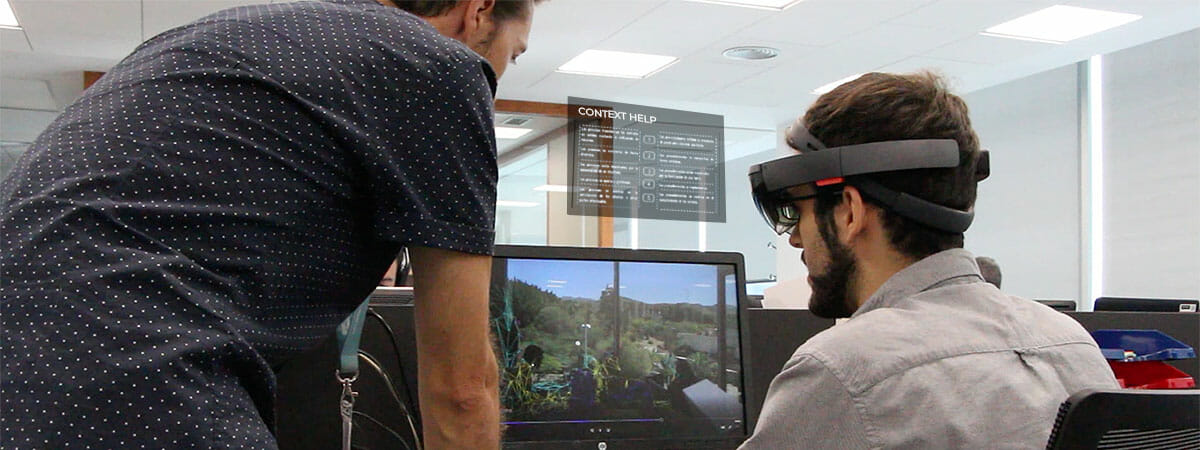In the 21st century, technology is advancing in big strides, often turning fiction into reality overnight. Managing a virtual blackboard full of information as shown in some movies (Ironman, Avatar…) is one of these cases. It is what is called, depending on the case, augmented reality and mixed reality, although for now… we need glasses to be able to do it.
Industrial experiences carried out with augmented reality mostly show an increase in precision, faster tasks, less operator fatigue and, above all, the near disappearance of human error.
Augmented reality and mixed reality glasses are an interface through which virtual elements can be displayed over the physical reality that surrounds us. For example, in our work setting we could see how an installed object should look like before actually installing it. The work area would be the real world, while the installation is the virtual vision or image superimposed on it.
The process that allows us to do this is not easy, as it requires programming the device that is necessary for each specific task. Image recognition is used for these purposes, such as a QR code placed in a strategic location in order to have reference points that allow the virtual elements to be positioned correctly after determining their position through mathematical calculations. There is also the possibility of using the augmented reality glasses without markers, but it is a more complex process that implies a higher error rate, for the moment.
This is a technology that has only been with us for a few years and is still being developed for different industries. In fact, the industry is betting heavily on it thanks to the advantages it provides when performing a task, increasing precision, the speed of task execution and, above all, minimizing human error.
Technology giant Microsoft is being one of the pioneering companies to develop devices that allow access to this augmented reality. A few years ago, the company launched an autonomous holographic device, baptized as HoloLens. Its creator, Alex Kipman, is prudent when it comes to acceptance of this type of device, emphasizing that, just as it had occurred with the emergence of tablets, human beings need time to accept and adapt to these new and innovative devices. He also believes that once the time comes when its use extends beyond the industry, it will mean a before and after in the use of mobile phones and computers as we know them today.
In the aeronautical sector, the use of augmented reality or mixed reality glasses, as in the case of HoloLens, can be a real revolution based on the first experiences that have already been put into practice through their use in some pilot projects. Its great contribution in the coming years could be the replacement of a big part of the documentation that is generated when conducting aircraft manufacturing or maintenance tasks. But not only that, as the information will become readily available in the same work environment, on the very surface or element on which the task is to be carried out and, above all, in a contextualized way.
Aircraft manufacturers, including Airbus, continue to develop “TIs” or “technical instructions” to document the work that must be done on aircraft. The methodology was revolutionized relatively recently, by implementing three-dimensional models that help operators execute each task. However, the opportunity presented by the implementation of augmented reality glasses is to offer more contextualized information about the work environment itself, while facilitating greater interaction.
Augmented reality offers a virtual image that is projected onto the real one (in this case, the aircraft), offering specific visual information on all the elements that affect the task, establishing traceability and indicating each step that must be followed, with a visual indication in each case. The objective is clear: reduce task execution times, reduce the mental fatigue accumulated by the operator and, consequently, minimize human errors.
For example, the installation of electrical harnesses is usually a complex task, since they have fastening flanges implanted in specific places and a certain route that must be followed scrupulously. The use of these glasses would allow the operator to visualize the correct route of the wiring, as well as the exact location of each one of the fastenings. But before reading on, let’s take a moment to understand this last point…
Imagine an area where you have to install a cable. It is certainly possible to make a mistake by misinterpreting the documentation and performing the wrong installation at any given moment, after many accumulated hours of work, or by shifting one’s attention momentarily to an external agent. Let us bear in mind that there are different systems and equipment in a small space on an airplane that could be easily confused at the time of installation. Fortunately, with the HoloLens, we would have a clear view of the work area and visual indications of what we must do, requiring us to simply imitate what our eyes are seeing. With this method, both installation and patch work can be done at the same time.
However, not everything is rosy in this new tool. According to experts, it could generate visual fatigue similar to working with screens, forcing possible or required breaks after certain times of prolonged use.
On the other hand, the software continues to be improved to make the user interface more and more intuitive and easy to use. For now, users must go through several menus before they can get the job done, and navigation still requires some tweaking when it comes to usability. In fact, the use of these devices requires prior training of the staff to get the most out of them in work areas. In addition, from the health & safety point of view, the use of these glasses can distract people from the real environment in which they are used, which requires learning to minimize bumps or even falls.
Many of the companies that work in the aerospace sector are already working with this type of device and implementing this technology in aeronautical projects, helping to mature the technology and properly understand its usability.
Indeed, and as has happened with other innovations before, the future may offer us a new way of performing technical tasks with greater efficiency, all throughout. There is still time until the use of augmented reality is seen as normal, but there are industrial environments where, far from being something of the future, it is already a commitment very present today.



